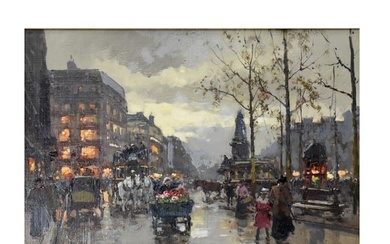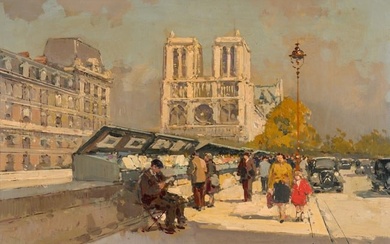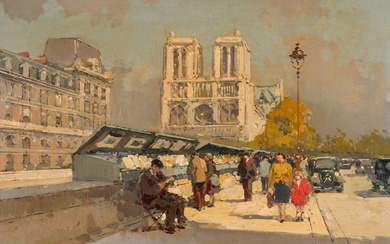Édouard Léon Cortès (French, 1882–1969), , Le Moulin
Édouard Léon Cortès (French, 1882–1969)
Le Moulin Rouge, Place Blanche
Signed 'EDOUARD [sic] CORTÈS.' bottom right; also with 'copyright' stamp verso, oil on canvas
13 x 18 in. (33 x 45.7cm)
Executed in 1956.
PROVENANCE:
Galerie F. Clair, Paris (1956).
Acquired directly from the above on January 2, 1957.
Herbert Arnot Inc., New York, New York.
Acquired directly from the above on January 18, 1957.
The Haussner's Restaurant Collection, Baltimore, Maryland.
Sotheby's, New York, sale of November 2, 1999, lot 132 (B).
Acquired directly from the above sale.
Hammer Galleries, New York, New York.
Acquired directly from the above in 2000.
Private Collection, Bronxville, New York.
EXHIBITED:
Hammer Galleries, New York, New York, 2000.
LITERATURE:
Hammer Galleries, An Exhibition Catalogue, 2000, no. 26869-002, p. 28.
Nicole Verdier, "Paris 1940-1969," in Édouard Cortès, Catalogue Raisonné de l'Oeuvre Peint, Vol. II, Contexte, Paris, 2002, no. 865, p. 204, (illustrated).
NOTE:
Édouard Cortès was born in the small village of Lagny-sur-Marne in 1882. The son of famous Spanish court painter Antonio Cortès, he trained in his father's studio from the age of thirteen. Although his hometown was sparsely populated, its proximity to Paris attracted many Parisian artists associated with the Barbizon school, who came to paint its adjoining forests. It also enabled the Cortès family to travel to the capital and keep up with the latest artistic trends.
By 1900 Cortès had executed his first series of Paris street scenes, all marked by a dark, dramatic lighting. At the time, Paris was the center of the art world, a bustling international city that attracted artists, dealers, and collectors from around the globe. City scenes were particularly in demand, and Cortès, alongside painters like Jean Béraud and Eugène Galien-Laloue, wisely decided to make this genre his niche. Through his bold brushstrokes and colorful palette, Cortès was able to render the City of Lights with an Impressionistic delicacy, at the same time respecting the fundamental rules of perspective and composition he had learned from his father.
He became the most famous poetic recorder of the city's ever-changing beauty, and in a career spanning more than sixty years captured its fashionable inhabitants, busy market stalls, and iconic monuments. Biographer David Klein writes: "Paris changed during the years that Cortès painted it; and the changes appear in his paintings. Horses and carriages disappear in favor of cars and trams; women's hourglass silhouettes and picture hats give way to boyish figures in short skirts and little furs, gas streetlights turn into neon signs and glaring headlights. But despite two world wars and the introduction of the machine age, the Paris of Cortès remains primarily the city of the Belle Époque. His paintings are often filled with nostalgia for the period." (David Klein, Édouard Cortès: Le Poète Parisien de la Peinture, Detroit, 1999 quoted in Mary Manion, "Esteem is Rising for Édouard Léon Cortès" in Antique Trader, September 14, 2018).
After a lifelong dedication to capturing the magic of Paris during its transition from the Belle Époque to the modern era, Cortès ultimately retired to his hometown, where he continued to paint more picturesque scenes until his death in 1969.
Since the Moulin Rouge opened its doors to the public in 1889, the famous cabaret in Montmartre has drawn large crowds of fashionable Parisians in search of guilty pleasures nowhere else accessible. Of the many Parisian views that Édouard Cortès completed, often depicting Notre Dame, Opéra Garnier or Boulevard de la Madeleine, only a handful of paintings and studies feature the Moulin Rouge. This excitingly rare work is one of the finest and earliest examples of Cortès’ bold, painterly style. Executed some ten years before the artist’s death, the painting skillfully captures the glowing red exterior of the cabaret juxtaposed against a dark sky, offering a glimpse of the temptations to be found within. The windmill’s striking silhouette, surrounding street lamps, and nearby facades inundate the passersby in the foreground with a warm, golden light that compels them to enter the Moulin Rouge, perhaps also tempting the viewer to leap into the picture plane and join them. Dimensions:
Sale price
Estimate
Time, Location
Auction House
Édouard Léon Cortès (French, 1882–1969)
Le Moulin Rouge, Place Blanche
Signed 'EDOUARD [sic] CORTÈS.' bottom right; also with 'copyright' stamp verso, oil on canvas
13 x 18 in. (33 x 45.7cm)
Executed in 1956.
PROVENANCE:
Galerie F. Clair, Paris (1956).
Acquired directly from the above on January 2, 1957.
Herbert Arnot Inc., New York, New York.
Acquired directly from the above on January 18, 1957.
The Haussner's Restaurant Collection, Baltimore, Maryland.
Sotheby's, New York, sale of November 2, 1999, lot 132 (B).
Acquired directly from the above sale.
Hammer Galleries, New York, New York.
Acquired directly from the above in 2000.
Private Collection, Bronxville, New York.
EXHIBITED:
Hammer Galleries, New York, New York, 2000.
LITERATURE:
Hammer Galleries, An Exhibition Catalogue, 2000, no. 26869-002, p. 28.
Nicole Verdier, "Paris 1940-1969," in Édouard Cortès, Catalogue Raisonné de l'Oeuvre Peint, Vol. II, Contexte, Paris, 2002, no. 865, p. 204, (illustrated).
NOTE:
Édouard Cortès was born in the small village of Lagny-sur-Marne in 1882. The son of famous Spanish court painter Antonio Cortès, he trained in his father's studio from the age of thirteen. Although his hometown was sparsely populated, its proximity to Paris attracted many Parisian artists associated with the Barbizon school, who came to paint its adjoining forests. It also enabled the Cortès family to travel to the capital and keep up with the latest artistic trends.
By 1900 Cortès had executed his first series of Paris street scenes, all marked by a dark, dramatic lighting. At the time, Paris was the center of the art world, a bustling international city that attracted artists, dealers, and collectors from around the globe. City scenes were particularly in demand, and Cortès, alongside painters like Jean Béraud and Eugène Galien-Laloue, wisely decided to make this genre his niche. Through his bold brushstrokes and colorful palette, Cortès was able to render the City of Lights with an Impressionistic delicacy, at the same time respecting the fundamental rules of perspective and composition he had learned from his father.
He became the most famous poetic recorder of the city's ever-changing beauty, and in a career spanning more than sixty years captured its fashionable inhabitants, busy market stalls, and iconic monuments. Biographer David Klein writes: "Paris changed during the years that Cortès painted it; and the changes appear in his paintings. Horses and carriages disappear in favor of cars and trams; women's hourglass silhouettes and picture hats give way to boyish figures in short skirts and little furs, gas streetlights turn into neon signs and glaring headlights. But despite two world wars and the introduction of the machine age, the Paris of Cortès remains primarily the city of the Belle Époque. His paintings are often filled with nostalgia for the period." (David Klein, Édouard Cortès: Le Poète Parisien de la Peinture, Detroit, 1999 quoted in Mary Manion, "Esteem is Rising for Édouard Léon Cortès" in Antique Trader, September 14, 2018).
After a lifelong dedication to capturing the magic of Paris during its transition from the Belle Époque to the modern era, Cortès ultimately retired to his hometown, where he continued to paint more picturesque scenes until his death in 1969.
Since the Moulin Rouge opened its doors to the public in 1889, the famous cabaret in Montmartre has drawn large crowds of fashionable Parisians in search of guilty pleasures nowhere else accessible. Of the many Parisian views that Édouard Cortès completed, often depicting Notre Dame, Opéra Garnier or Boulevard de la Madeleine, only a handful of paintings and studies feature the Moulin Rouge. This excitingly rare work is one of the finest and earliest examples of Cortès’ bold, painterly style. Executed some ten years before the artist’s death, the painting skillfully captures the glowing red exterior of the cabaret juxtaposed against a dark sky, offering a glimpse of the temptations to be found within. The windmill’s striking silhouette, surrounding street lamps, and nearby facades inundate the passersby in the foreground with a warm, golden light that compels them to enter the Moulin Rouge, perhaps also tempting the viewer to leap into the picture plane and join them. Dimensions:







